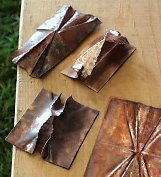|
||||
|
|
|
|||
|
|
||||
|
|
||||
Charles Lewton-Brain, Canada : This was what we call a real "sleeper", a surprise value.
Charles has invented, yes INVENTED, a new form of basic metalworking. I would not have
believed it if I had not seen it with my own eyes. In some 5,000 odd years of metalworking
someone has invented a NEW and BASIC form of metalworking! He calls it Fold-forming. It is
so basic and simple that if it had existed at any time in the past there would be tons of extant
examples. Most likely there would be whole schools based on the discipline of Fold-forming.
But there is not and this and the fact that only the most basic tools (a hammer and a vise) is
required is the most convincing evidence that is a NEW invention. According to Charles'
literature,The British Museum research lab has confirmed that it is a completely new way to work metals.  Fold-forming is the process of creating surface textures, relief's or volumes from ductile
material using simple techniques that stretch portions of the material in a predictable manner
producing reproducible results.
Fold-forming is the process of creating surface textures, relief's or volumes from ductile
material using simple techniques that stretch portions of the material in a predictable manner
producing reproducible results.In its simplest form the material is folded, creased and then "opened" or unfolded. This leaves a permanent raised line. If you fold again at another angle, a new raised line will be created going over and including the first line.  In it's more complex form
Fold-forming creates raised surfaces similar to high relief and volumes that can be used to create
vessels or provide volume with little mass.
In it's more complex form
Fold-forming creates raised surfaces similar to high relief and volumes that can be used to create
vessels or provide volume with little mass.Originally invented for work in precious metals Fold-forming can be applied to any malleable, plastic material and has been translated to steel plate with great success. For more information contact: Brain Press Box 1624, Ste M Calgary, Alberta T2P 1N3 CANADA 403.262.3955 brainnet@cadvision.com or http://www.ganoksin.com/borisat/tip_sear.htm Charlie Sutton, Ontario, Canada: Charlie is the author of Under a Spreading Chestnut Tree, Basic Blacksmithing. Charlie's book is full of good practical information and techniques. His demonstration reflected that practicality. When we got there he was demonstrating riveting a handle on a shovel. Next he produced a scroll jig with a fishtail end. The fishtail is forged to one side so that the end of the scroll can be started on the raised part (the tapered end is also convenient for fitting spiral or bean end scrolls). The jig was bent to match a hand drawn scroll on a sheet of steel. Later a shank was arc welded on that would fit in a vise or hardy hole. - We will have a review of Charlie's book in the near future. Bill Fironi, We have seen Bill's demo at several places and all I can say is you have to be there. Bill easily manipulates various steels into laminated steel or numerous type of Damascus. If you want to learn about the details of the art Bill is a great one to see. In three days Bill produced dozens of billets and explained every detail of the process. Kirsten Skiles, demonstrated heavy relief in steel plate. Her work looks like repose' but it is all worked from the front. The background metal is driven down into the mastic rather the other way around. We saw both Bill and Kirtsen at the Blacksmiths of the Potomac "Spring Fling" (See Vol. 12 of the news). |
||||
|
|
||||
|
| iForge | Touchmark Registry | What's New! | Links | Rate Card | Web Ring Nexus | | ||||
Comments to: Editor @ anvilfire.com |
|
|||

